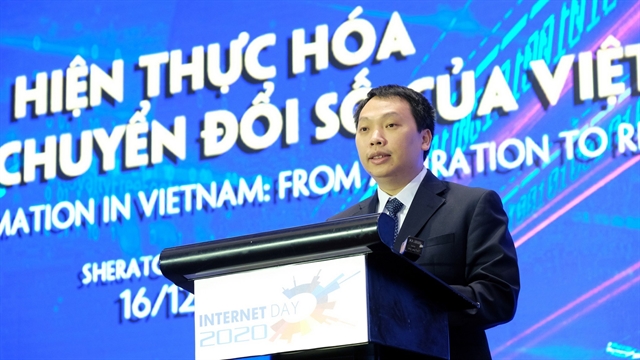 Economy
Economy


|
| Nguyễn Huy Dũng, Deputy Minister of Information and Communications, speaks at the Internet Day 2020. — VNS Photo |
HÀ NỘI — The internet had made positive contributions to the overall socio-economic development of the country since Viet Nam connected to the Internet for the first time 20 years ago, said Nguyễn Huy Dũng, Deputy Minister of Information and Communications, at Internet Day 2020.
The Việt Nam Internet Association (VIA) organised Internet Day 2020, which is one of the biggest events of the year in the internet industry, on Wednesday.
This year was the starting year for the national digital transformation. Instead of simply digitising documents and processes, the development of digital technology allowed us to bring all of our operations into cyberspace, said Dũng.
This movement would take place at a rapid rate, creating a great impact on all three pillars, which are digital government, digital economy and digital society, he added.
In addition to looking back on the 20-year development path of Việt Nam's internet, Deputy Minister Nguyễn Huy Dũng also emphasised that it was the time to express the desire to bring Vietnamese digital footprints further and further into global cyberspace.
In order to realise the aspirations for national development, Việt Nam must quickly seize the opportunity and implement digital transformation faster, stronger and more broadly, noted Dũng.
To do that, the Ministry of Information and Communications would implement a number of major orientations, including continuing to expand the ability to access the internet, towards universal connectivity.
The goal of the national digital transformation programme is that each citizen has a smartphone and each household has a high-speed fiber-optic internet line.
Another important direction was the development of national digital infrastructure to meet the new requirements for the explosion of IoT smart devices and machine-machine communication; completely transforming Vietnamese internet into IPv6 address space and making the country a regional internet hub.
The ministry will also develop an ecosystem of digital platforms, expand national cyberspace and the scope of Make-in-Vietnam digital platforms.
In addition, ensuring information security, mastering digital infrastructure, cyberspace and protecting national digital sovereignty were also prioritised tasks, he emphasised.
Citing some reports, Vũ Hoàng Liên, VIA chairman, said that Việt Nam is considered one of the 20 countries with the highest internet penetration rate in the world with 68.17 million users, accounting for 70 per cent of its population.
About 94 per cent of Vietnamese users use the internet regularly with an average usage time of up to six hours per day. In addition, the country’s internet economy will continue to grow at a double-digit rate this year, reaching nearly 17 per cent, the highest growth rate in Southeast Asia.
Liên said the internet had become an essential service for everyone. Vietnamese people had a lot of prospects on the internet environment.
Sharing more about the development of the country's digital economy, Nguyễn Trọng Đường, Deputy Director of the Authority of Information Technology Application, Ministry of Information and Communications, said that Việt Nam currently has about 45,500 ICT enterprises. Total revenue of these enterprises is estimated at US$126 billion, including contributions from FDI enterprises.
The proportion of information and communication technology exports currently accounts for about 30 per cent of the total national export value. The country's ICT exports currently account for three per cent of global ICT exports.
Google's e-Conomy report showed that the COVID-19 pandemic had become a driving force for the skyrocketing number of new users of digital services in Việt Nam and many Southeast Asian countries.
The number of new users of digital services in Việt Nam grew by 41 per cent in the past year, the highest in the region.
The total revenue of the country's internet economy will reach more than US$14 billion this year. In which, e-commerce accounted for the highest proportion, accounting for about $7 billion, followed by online communication ($3.3 billion), and transportation and food ($1.6 billion). — VNS




